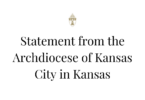
by Joe Bollig
joe.bollig@theleaven.org
MOUND CITY — Among the Potawatomi Indians of St. Mary’s Mission at Sugar Creek near here in 1841, there was a French nun who became known as “Quahkahkanumad,” or “the woman who prays always.”
Today, we know her as St. Rose Philippine Duchesne.
The legacy of the missionary saint and the destiny of the Potawatomi Indians joined again when Jerry Tuckwin, a member of the Prairie Band of the Potawatomi Tribe, received the St. Rose Philippine Duchesne Award after Mass on Nov. 21 at Sacred Heart Parish in Mound City.
“I am very honored and feel very humble to receive this award,” said Tuckwin. “There are hundreds of others who should receive it. In my own way, I’m grateful and hope it can be a little bit of inspiration to Native American Kansans.”
Jerry and his wife Terry are members of the permanent community of Tekakwitha House, the Catholic campus center at Haskell Indian Nations University in Lawrence. They have a son John. A daughter, Shannon Beth Tuckwin-Rolland, died in 2016.

Not only was Tuckwin the first Potawatomi to receive the award, but he was also the first person to be nominated by another Potawatomi — retired Archbishop Charles Chaput, OFM Cap., of the Archdiocese of Philadelphia, the first Native American to be ordained a bishop in the United States.
The Duchesne Award has been conferred annually since 2006 to individuals and groups who promote Catholic education, vocations to the priesthood and religious life, or have a devotion to St. Rose Philippine Duchesne.
The award was given to Tuckwin by Archbishop Joseph F. Naumann at the parish, which is also a shrine to St. Rose.
The Catholic Potawatomi were forced from their lands in Indiana by the U.S. government in 1838. They, and some Jesuit priests who ministered to them, walked the Trail of Death to Sugar Creek in Linn County, where they remained.
Sister Rose Philippine, a member of the Sacred Heart order in St. Louis, decided to move to Sugar Creek in 1841 to start a school for Potawatomi children, despite being 71 years old. Although she was only able to stay a short time, she made a big impression.

In 1846, the Potawatomi moved from Sugar Creek Mission to the reservation north of Topeka and became known as the Prairie Band Potawatomi. Those who moved to a reservation in Oklahoma in 1867 became the Citizen Band Potawatomi.
Tuckwin’s ancestors walked the Trail of Death and knew St. Rose. He was born one-and-a-half miles south of Our Lady of the Snows Shrine on the Kansas reservation.
Tuckwin went to high school at the Haskell Institute from 1956-1960. After graduating from Wichita State University, he served in the U.S. Air Force from 1966-1970 with a tour in Vietnam, and then returned to Haskell.
At Haskell, he taught health and physical education. He became athletic director and head of the academic sports center. He mostly coached track and basketball, but he also coached golf, baseball and football. He retired in 2001.

Jerry and Terry were also key players in Catholic campus ministry at Haskell. While he was in high school, Jesuit priests from St. Marys would travel to Haskell to celebrate the sacraments.
“I came back in 1970, after I got out of the service,” said Tuckwin. “We didn’t have Mass on campus because the Jesuits left St. Marys. We would get what we could, as far as our spiritual needs were concerned. We held some service every week for the kids, whether it was with a priest from [Lawrence], the Potawatomi Reservation or wherever.”
Finally, the Tuckwins and others worked with then-Archbishop Ignatius J. Strecker and the Capuchin Franciscans to establish the Haskell Catholic campus ministry.
Although he didn’t know anything about St. Rose Philippine Duchesne while he was growing up, as an adult Tuckwin learned more and came to appreciate her. He took his family to Rome for her canonization on July 3, 1988.
When Tuckwin’s parents were killed in a house fire when he was only 7 years old, he relied heavily on his faith in the years that followed.
“I have learned about [St. Rose Philippine] helping to bring Catholicism [to the Potawatomi], along with the Jesuits at St. Marys,” said Tuckwin. “Her influence, indirectly, was to introduce to many of us Catholicism, although she was not here personally during our formative years. She definitely made a great impression on me.”






